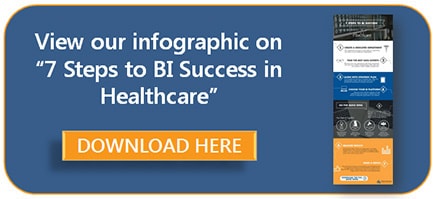
In the earlier blog post, “Charting a Roadmap for BI Success in Healthcare,” I discussed how the healthcare landscape is changing, and how business intelligence (BI) is an important technology in that discussion. I also introduced 7 steps for BI success, gleaned from the experience of our customer Henry Mayo Newhall Memorial Hospital. To recap, the 7 steps are:
- Create a dedicated department
- Staff it with the best data experts
- Align with the hospital’s strategic plan
- Select the most appropriate BI platform
- Choose projects that yield “quick wins”
- Measure and monitor results
- “Rinse & repeat”
We examined the first 4 of these steps in the previous blog post. In this post, we’re going to take a closer look at Step 5 – choosing projects that yield “quick wins” and looking at how you can achieve ROI in 12 months or less.
Why are quick wins important?
Quick wins provide organizations with momentum and confidence that they have invested their dollars wisely. They also engage user communities in driving improvement through information leading to more immediate ROI.
It’s similar to the experience of a runner. In the novice stage of the sport, you don’t try to run a marathon. Instead, you go for a progression that helps you to gain confidence. Along the way, you assess what works and what doesn’t to build up to the next level, whether it’s a 10K or a marathon. And maybe in the end, you decide that you’re satisfied with just the short races, which still improve your fitness and are good for your psyche.
You can approach BI in the same way. If you try and accomplish everything right out of the gate, you’re most likely not going to be happy with the result. It’s much better to start small, get some quick wins and learn from them along the way. Dimensional Insight customer Henry Mayo set small goals to get a quick ROI from its BI investment in less than 12 months. Let’s take a look at 4 ways you can do the same.
#1: Start small. Keep it simple.
As with our running example, in the early stages of your BI journey, you’ll want to choose initiatives that allow you to develop basic competencies and gain experience while accomplishing something tangible that will add to your confidence. It may be tempting to take on bigger projects with greater potential wins, but you run the risk of overwhelming your staff, and yourself, and frustrating your user community. Stay focused on the quick win and build up both excitement and morale throughout the organization.
For example, Henry Mayo wanted to improve patient flow in a number of areas. Instead of trying to tackle this all at once, though, it concentrated first on improving workflow in the emergency department. By breaking its project out into much more manageable phases, Henry Mayo was able to get some fast results, which only encouraged users and management. According to Cindy Peterson, Henry Mayo’s VP/CIO, “One key to our success was taking a modular, phased approach. We didn’t take the approach of developing a large data warehouse with every data element in it that we thought we might need. We stayed focused. It helped us get to a win faster and produce good results in a quicker fashion.”
#2: Avoid going rogue. Every hospital has a strategic plan – use it.
Strategic plans provide context for day-to-day activities and they give employees and departments a sense of how their contributions fit into the larger picture. For many individuals, this context provides meaning and increases employee engagement and productivity. Strategic plans live and die by their ability to measure performance. Are we doing better? Worse? Maintaining status quo? The strategic plan is a succinct outline of exactly what areas need to be measured and where organizations need to focus energy.
Henry Mayo looked to its strategic plan when it embarked on its BI journey, and worked to improve patient flow as one step towards becoming a more patient-centered organization. Henry Mayo’s Cindy Peterson says, “We used the hospital’s strategic plan as a way to prioritize our list of projects. It’s a good strategy to make sure you are working on things that will ultimately drive value for the organization and produce results.”
One large benefit of adhering to a strategic plan is that it grants you the permission to say “no” (or at the very least discuss trade-offs). After plans are rolled out, they often lose momentum. New requests crop-up and all of a sudden there’s a backlog of “priorities”. With the strategic plan as a reference point, you can point out that it’s off-plan or at least have a constructive dialog about priorities and timelines.
#3: Strive for a single tool environment.
End-user adoption is critical to success. This can only be achieved if there’s confidence in the data. By consolidating development of BI content to one group and standardizing on one tool, you can maintain data integrity, apply business rules consistently and systematically, and allow your business users to focus on taking action instead of worrying about the validity of specific numbers.
In addition, standardizing on a single tool accelerates development productivity. Analysts become more proficient in using a standard tool set, training costs can be minimized and bottlenecks due to varied skill sets can be nearly eliminated. Resource allocation is much easier to manage. As a result, projects are delivered to business users much more quickly than they are in multiple tool environments.
#4: Use consulting services for knowledge transfer.
Most BI implementations will include training for developers and end users as part of the core roll-out. However, you can also use your vendors’ consulting services as a form of “immersion” training for your newly formed team of BI developers. By budgeting in additional consulting services or swapping out training time for additional consulting, your team will get the added benefit of shadowing an individual with greater expertise in a new tool set. Using this approach allows you to complete initial projects more quickly, builds confidence in the selection of a given tool and provides greater satisfaction with deployed staff resources.
If you use this approach, it’s important to stay disciplined. When a consultant is on-site, your team must be highly involved. Resist the urge to let these consulting resources work independently because your in-house resources are too busy putting out other fires. Spend ample face-time, be inquisitive, and have the team learn the tricks of the trade to increase their own efficiency levels and build product expertise.
By following these methods, you can gain ROI in 12 months or less. In the next blog post, we’ll examine how to measure and monitor your results, as well as learn lessons that you can apply to subsequent projects.
Ready for a test drive of our healthcare analytics software?
- Practical Analysis: The Next Chapter - May 21, 2020
- Exploratory Data Analysis Part 2: Helping You Make Better Decisions - October 11, 2019
- Practical Analysis: Understanding Visualization Concepts - September 19, 2019



